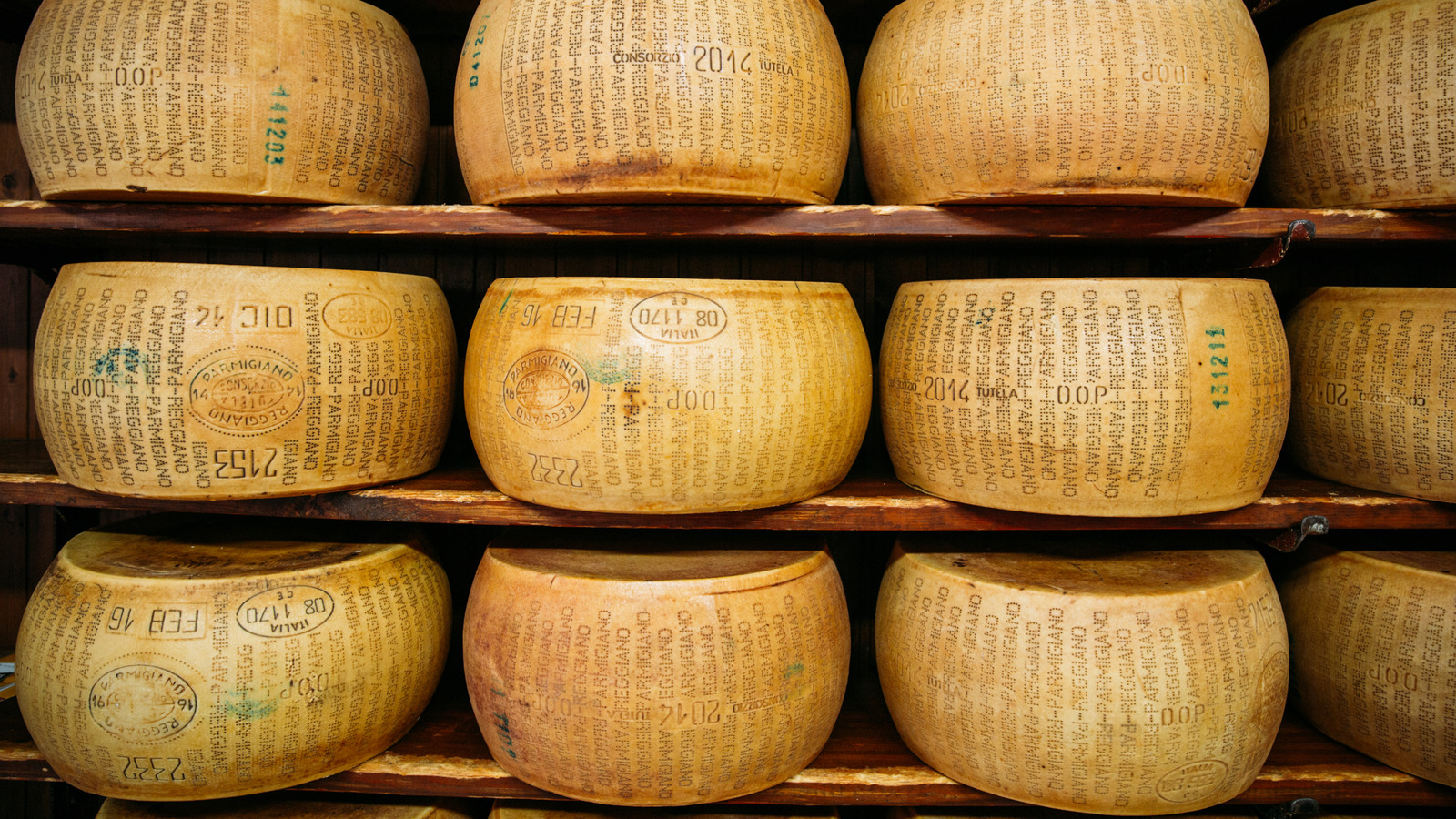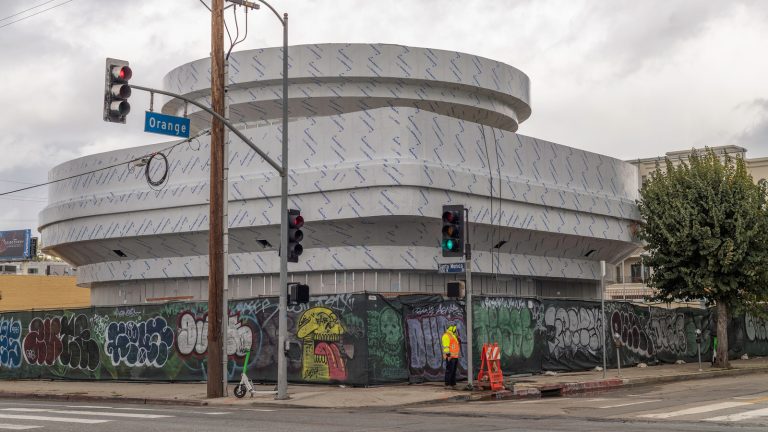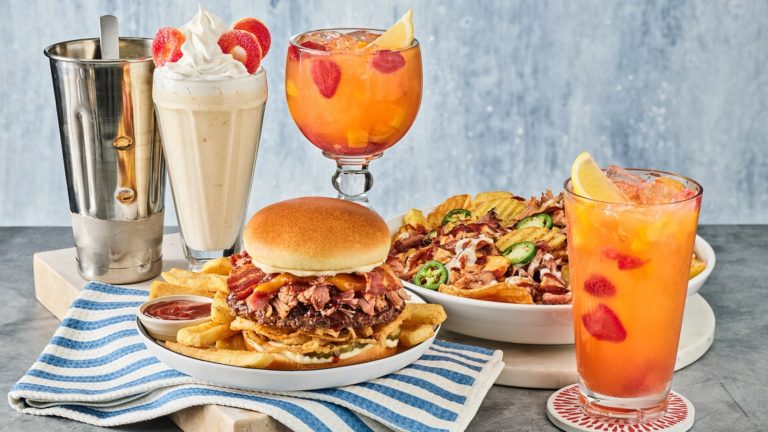Cheese is a fascinating substance full of personality and mood. It comes in a bewildering variety of shapes, sizes, colors, smells, and textures and is instrumental in an equally bewildering range of dishes, from appetizers to dinner and dessert. There’s a best cheese for lasagna, a best cheese for nachos, and a best cheese for cakes. Age can alter it considerably. Indeed, cheese can even sweat. Need one say more? Things get even more interesting when you take a look at the cheese wheel, a product that many of us don’t spend much time thinking about yet interact with all the time: Cheese is frequently sold by the wedge, after all, and those wedges have to come from somewhere.
There’s a science behind cheese wheels as well. Or, if you’re to believe some enthusiasts, it’s actually magic. “Okay, science and magic,” say Jeremy Bossio and Alexis Cobham, co-founders of Cheese Maker. “It’s one of the few foods where a bit of time, bacteria, and know-how can turn milk into something legendary.” Perhaps the most amazing thing about cheese wheels, though, is that you don’t need a master’s degree in caseiculture, or the art of making cheese, to enjoy cheese. You can make it right at home, they say, “no fancy cave required. Whether it’s your first mozzarella or you’re aging your own cheddar, you’re part of a tradition that’s thousands of years old — and still full of surprises.” If you’re on the fence about whether to try your hand at a fine gouda, here are some cheese wheel facts that might just inspire you to give it a whirl.
Cheese wheels are prehistoric
The humble but delicious cheese wheel goes back to prehistoric times. While this is among the coolest facts about them, it is also kind of a bummer, because “prehistoric” means before humans kept written records, so experts have to guess about what was going on. “Cheesemaking was discovered around 9,000 years ago,” says Zoe Brickley, director of Communications and E-Commerce at Jasper Hill Farm. “It is considered to be a catalyst of modern civilization for its ability to allow groups of people to keep a constant source of nutrition as they migrated to greener pastures, moving out from the over-farmed Fertile Crescent.” Archeologists have also found woven baskets and pottery fragments that suggest the cheese wheel was likely an early shape.
What’s more, cheese almost certainly didn’t result from an intentional series of experiments. Rather, says Chris Osborne, a cheesemaker at luxury resort Blackberry Farm, “It was likely created by accident. Somebody thousands of years ago decided to store milk in an animal stomach, which contained rennet, an enzyme that naturally curdles milk into cheese.” It was such an obviously useful innovation that people continued to do it. As Jeremy Bossio and Alexis Cobham put it, “You realize over time that most traditions come from common sense.”
Their shape originally helped with easy transport
Not only was cheese a more portable form of milk, but “the wheel shape made it easier to transport the cheese as people moved from place to place,” Chris Osborne says. Very large cheese could be rolled rather than carried, for one thing. (Actually, cheese rolling is a sport of likely pagan origins that is still practiced today, such as in some parts of England.) It was also easier to manage and store, Jeremy Bossio and Alexis Cobham say: “Before refrigeration and electricity, we weren’t just trying to make things look fancy — we were thinking function first. Cheese has always been about turning humble ingredients into something that lasts.”
Eventually, Zoe Brickley says, folks turned to even more economical shapes. Square blocks, for instance, allow you to stack cheese without any wasted space on ripening shelves and wooden transport crates. And, at some point in time, human carpentry skills “advanced to the point where wooden forms would have been just as practical as hand-woven baskets and certainly pottery.” Why, then, are cheese wheels still common? “Wood is heavy and prone to degradation in damp cheesemaking conditions,” she says, so it’s not always the best choice.
Cheeses generally keep the shape of the draining form used
As discussed, a cheese wheel does not randomly take on a round shape. Rather, it is defined by the draining form. “To make cheese,” Zoe Brickley explains, “milk is acidified with the help of starter cultures and then coagulated with the help of a natural enzyme. Coagulated curd is then, generally, cut and stirred to allow the watery whey to seep out from the curds to whatever extent the cheesemaker allows, depending on how soft or firm the end texture is targeted to be.”
When they’ve reached the desired firmness, the cheesemaker removes the curds from the whey and puts them into a draining form, where they will continue to shed excess whey, she says. As the cheese hardens, it will take on the shape of the form into which those curds were piled. Even cheeses that are wrapped in wax will get their coating after the cheese is removed from the form, so you can still tell what shape was used.
Most pre-industrial cheeses were round
Back in the day, draining forms — and thus cheeses — were almost always round, Zoe Brickley says: “Common pre-industrial vessels like woven baskets and thrown pottery were the go-to perforated draining forms.” Or in some cases, she adds, curds simply assumed the shape of the vat, also round and resulting in a cheese wheel. Other traditional methods include draining cheese in cloth sacks, “which flatten into a round shape when resting on a table or keep a gourd-like shape — see cacciocavalo — when hung to dry.”
At the end of the day, she says, a cheese’s shape was a product of necessity and using the materials at hand, “as opposed to a deliberate aim of someone thinking to themselves, ‘I wish my cheese were rounder.'” The only pre-industrial types Brickley can think of that weren’t round are 18th century Pouligny St. Pierre, which take on a small pyramid shape, along with “a handful of Lombardian cubes and flat square shapes like Salva Cremasco and Taleggio,” which date back to the 10th century.
Wheel size matters
Another interesting cheese wheel fact is that wheel size matters. Chris Osborne says, “Alpine-style cheeses are made into larger wheels for a couple of reasons.” First, they’re easier to transport by rolling or carrying. Second, “larger wheels allow for a greater surface area to come in contact with the environment during the aging process. These cheeses have to age out for a longer period of time than other styles. As the moisture evaporates during the aging process, it concentrates the flavors, giving you a more complex finished product.”
Washed rind cheeses are another example, he says. These typically have high moisture content — think Epoisses or Taleggio (which is actually square). These cheeses get washed on a regular basis to smear yeast around and help with the development of a colorful red-orange rind, so they need to be smaller. That way, they can retain their moisture and softness. For instance, Brie wheels, which are about 18 inches thick at most, needs to be small and short, so that they can ripen all the way inside without the rind getting too thick, says Zoe Brickley.
On the other hand, cheddar is quite large. “Cheddar producers wanted a tall, barrel-shaped cheese with a long shelf-life and the durability necessary to stack them in the belly of ships for trans-Atlantic trade,” Brickley explains. That shape, however, led to rot or weird textures because the tall shape could trap too much whey. To address this, cheesemakers started milling and salting the curd for preservation, along with packing it tighter.
Some cheeses ripen inside-out and some outside-in
Not every cheese wheel ripens the same way, and the bacteria and mold at work have a lot to do with this. Take bloomy rind cheeses such as Camembert and Brie, for example. “These cheeses are inoculated with a P. candidum mold,” Chris Osborne says. “This white mold takes roughly two weeks to grow on the cheese once it hits the ripening room. These cheeses are often called surface-ripened cheeses, because they ripen from the outside in.”
First, the rind starts out thin and soft, then gets thicker and earthy-smelling over time. As it continues to ripen, the cheese will turn to cream all the way to the inside and a cream line will form between the paste (inside of the cheese) and the rind. Osborne explains that this means “the white mold rind is actively breaking down the proteins into smaller peptides and amino acids,” a process called proteolysis.
On the other hand, some cheeses ripen from the inside out. In this case, the bacteria goes to work on the paste first, metabolizing and transforming it into the harder cheeses we know today: cheddar and Swiss, for example. Swiss is one of the more extreme cases, as the bacteria do such a thorough job that they leave gas-filled holes behind.
Wheel shapes impact flavor and development
The cheese wheel took on such a specific shape due to a few crucial facts. “The wheel shape isn’t just pretty — it’s practical,” Jeremy Bossio and Alexis Cobham say. Curved edges help to distribute moisture more evenly and facilitate airflow, which leads to a healthy microbial spread and, thus, a consistent flavor and texture. Plus, corners dry out more easily, potentially leading to cracks or breaks that can ruin the cheese. Round shapes, on the other hand, can deal with more manipulation in the form of flipping, rotation, and movement as they age.
Plus, Chris Osborne says, “The round wheel also makes for a nice surface for mold to grow evenly during the aging process. The mold on the exterior of the wheel eventually pulls all the nutrients and moisture off the surface of the wheel and creates a natural protective barrier. This protective barrier is known as a natural rind,” as opposed to one that is added, such as cloth or wax. Moreover, Bossio and Cobham add, “Rounds have more surface area for beneficial rinds to form. So, when it comes to cheese, going around in circles is a good thing. Round cheese equals happy microbes and a tasty result!”
Microorganisms interact with a round rind in different ways
When you think of a cheese rind today, you’re apt to think of Babybel’s iconic minis with their wax rind. But not only do many cheeses, especially pre-industrial ones, have a natural rind, those rinds can take on oodles of different forms. “For the most part, the size and shape of the rind [or] cheese is very dependent on the style,” Chris Osborne says. “Mold and bacteria are going to find their way to thrive in the right environmental conditions no matter the shape of the cheese.”
Mold is actually a fungus, while bacteria are single-celled organisms, and both — along with yeast — metabolize the proteins and sugars in milk. These microorganisms influence how the cheese will look and taste in the end, and that is as true for the rind as the rest of the cheese wheel. For instance, Jeremy Bossio and Alexis Cobham say, “Washed-rind cheeses get their signature funk from Brevibacterium linens, which love the moist, salty surface of a wheel. Bloomy rinds, like Camembert, develop those snowy white coats from Penicillium candidum, which spreads evenly across a round shape.”
For a natural rind cheese, Zoe Brickley adds, “The rind is the main driver of cheese character — appearance and flavor. Rind-to-paste ratio affects drainage and then evaporative moisture lost during open air ripening.” The ratio also affects the concentration of flora and their distinctive effect on the paste within, she adds. For instance, the bacteria that make bloomy rinds have a shorter lifecycle, so you don’t see them on large cheeses, where they get overtaken during aging.
You can tell a lot about cheese by glancing at a wheel
A good cheesemaker can rattle off any number of facts simply by looking at the cheese wheel. For one thing, Zoe Brickley says, the rind is a hint. “For me, really excellent cheeses have a natural rind, as opposed to wax or plastic exteriors. They tend to have more interesting textures and complex flavors,” she says. “Sometimes, a more mottled appearance looks like a more complex or interesting cheese to me.” In great cheese shops, she says, you’ll find the same cheese in a range of ages, so you can choose how funky you want it to be.
In some ways, however, it’s easier to tell a bad cheese from first glance than a good one. A cheese wheel past its prime may look sad, slimy, brown, or darkened in appearance, Brickley says. To a certain extent, this is a matter of preference: “A little bit of bitterness and a whiff of ammonia can add to the je ne sais quoi, while a more sensitive palate might prefer a less developed profile.” She also clarifies that spots in the blue, gray, or green color spectrum are almost never signs of actual spoilage, so don’t rob yourself of a great experience by assuming they are.
At the end of the day, you won’t know until you try it. “You can’t necessarily see milk quality, salt content, or acid development just by looking at a cheese,” Chris Osborne says. The best bet is to get the help of a good cheesemonger, who will help you sample the product and sort out your preferences.
A cheese rind contains information
Many cheese wheels contain information to help you identify the cheese and certain aspects thereof. For instance, real Parmigiano Reggiano rind is stamped with the name of the cheese, Protected Designation of Origin (PDO) and Consortium inscriptions, the dairy identification number, the date of production, and the identification mark for the production plant. These are all pressed into the rind within hours of making the cheese.
Most cheeses aren’t as stringent in their seals as true Parmigiano Reggiano, which is sometimes hailed as the King of Cheeses, but others contain information as well. French cheeses usually contain the letters A.O.C. or A.O.P., while Pecorino Romano rind sports the name written out in capital letters composed of dashes. Manchego rind has a herringbone pattern that today comes mostly from molds but pays homage to a past in which cheesemakers wrapped the fresh cheeses in braided grass to cure. Cheesemongers acquire a deep facility with such facts, so you should feel free to ask them if you’re curious about a particular mark or seal.
Round cheeses are easier to cut evenly
Another of the cooler and less obvious facts about the cheese wheel shape is that it makes the cheese easier to cut. “Pie-wedge portions can more easily be made in a way that makes each portion more or less identical to the other in terms of rind-to-paste ratio,” Zoe Brickley explains. “As many early cheeses were natural-rinded by necessity (made before plastic and wax preservation prevailed), the ability to cut bigger or smaller pieces without leaving some with relatively more rind than others is a nice feature of the wheel shape.” On the other hand, she explains, it is difficult to cut a square into identical portions after you go past eighths, at least if you’re trying to take rind coverage into account.
This is yet another reason that many cheesemakers today choose to keep making wheel shapes, even if more space-savvy molds are widely available. “The ultimate modern expression of commodified cheese is a 40-pound block, made in stainless steel equipment and forms, and size-optimized for a standard 40- by 48-inch pallet,” she says.
There’s no upper limit on aging cheese
Most cheeses have a shelf life, but some cheeses have no technical upper limit. Parmigiano Reggiano, for instance, can be enjoyed at eight years and above, though most parmesan cheese on the market is between two and three years of age. On the other hand, Gouda is generally considered too old after five years and will taste like salted caramel.
However, it’s less about how old the cheese wheel is and more about how good each type is at each age. “A thicker rind usually means a longer aging process and a more complex flavor,” Jeremy Bossio and Alexis Cobham say. “Consider a Parmigiano Reggiano aged for years versus a soft Brie with its delicate 45-day bloom.” You can trust your sense of smell if you’re not sure, they add: “The nose knows!”
Wheels are perceived as higher-value than other forms of cheese
So, why do people continue to make cheese in wheels despite easier, more convenient, and more efficient methods? The answer, Zoe Brickley says, is a complicated one: posterity, regional identity, and a perception of value are all reasons “to keep the traditional format alive, or to re-create them in new world nods to the olden days. Now, ‘blocks’ are more closely associated with rindless industrial, commodity cheeses with a lower perception of value for experts and savvy customers.”
Indeed, some cheeses carry such a high price tag that they’re a target for theft. Believe it or not, cheese is the most stolen food in the world, so much so that there are whole articles online dedicated to famous cheese heists. Cheese simply has an aura of luxury, which is reflected in its value. It is for this reason that modern cheese still looks much like cheese of yesteryear.
That said, Jeremy Bossio and Alexis Cobham add, “Modern cheese wheels might look a lot like the old-school ones, but today’s wheels are crafted with better control over bacteria, moisture, and aging conditions. Artisan makers (like many of our DIY Cheese Maker fans) are experimenting with exciting flavors, milk types, and techniques that would’ve made a medieval cheesemonger say, ‘Wheely?'” Due to this expense, Chris Osborne says, “I appreciate getting to sample something before deciding to purchase to avoid buyer’s remorse.” Make sure you’re getting what you pay for.





